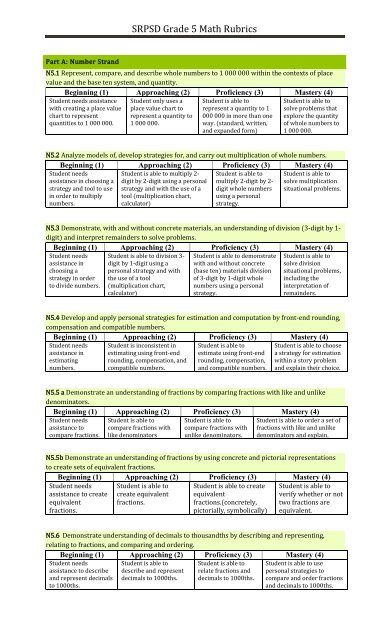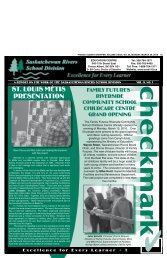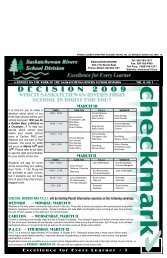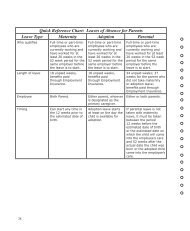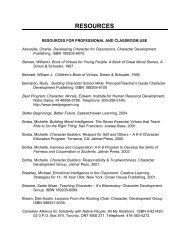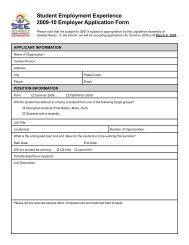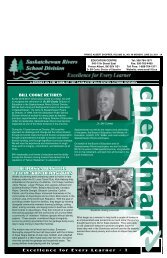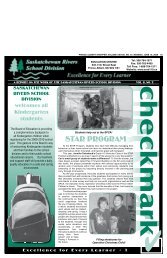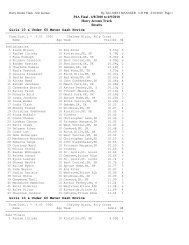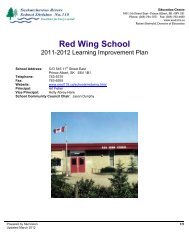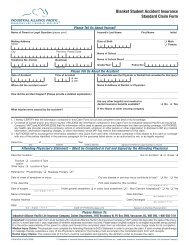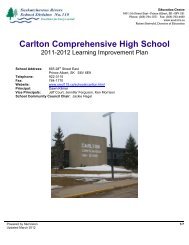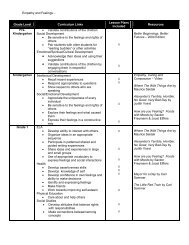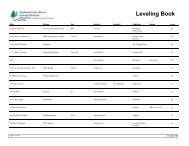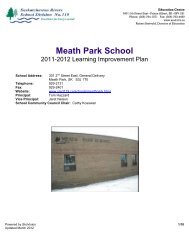SRPSD Grade 5 Math Rubrics
SRPSD Grade 5 Math Rubrics
SRPSD Grade 5 Math Rubrics
Create successful ePaper yourself
Turn your PDF publications into a flip-book with our unique Google optimized e-Paper software.
<strong>SRPSD</strong> <strong>Grade</strong> 5 <strong>Math</strong> <strong>Rubrics</strong><br />
Part A: Number Strand<br />
N5.1 Represent, compare, and describe whole numbers to 1 000 000 within the contexts of place<br />
value and the base ten system, and quantity.<br />
Beginning (1) Approaching (2) Proficiency (3) Mastery (4)<br />
Student needs assistance<br />
with creating a place value<br />
chart to represent<br />
quantities to 1 000 000.<br />
Student only uses a<br />
place value chart to<br />
represent a quantity to<br />
1 000 000.<br />
Student is able to<br />
represent a quantity to 1<br />
000 000 in more than one<br />
way. (standard, written,<br />
and expanded form)<br />
Student is able to<br />
solve problems that<br />
explore the quantity<br />
of whole numbers to<br />
1 000 000.<br />
N5.2 Analyze models of, develop strategies for, and carry out multiplication of whole numbers.<br />
Beginning (1) Approaching (2) Proficiency (3) Mastery (4)<br />
Student needs<br />
assistance in choosing a<br />
strategy and tool to use<br />
in order to multiply<br />
numbers.<br />
Student is able to multiply 2-<br />
digit by 2-digit using a personal<br />
strategy and with the use of a<br />
tool (multiplication chart,<br />
calculator)<br />
Student is able to<br />
multiply 2-digit by 2-<br />
digit whole numbers<br />
using a personal<br />
strategy.<br />
Student is able to<br />
solve multiplication<br />
situational problems.<br />
N5.3 Demonstrate, with and without concrete materials, an understanding of division (3-digit by 1-<br />
digit) and interpret remainders to solve problems.<br />
Beginning (1) Approaching (2) Proficiency (3) Mastery (4)<br />
Student needs<br />
assistance in<br />
choosing a<br />
strategy in order<br />
to divide numbers.<br />
Student is able to division 3-<br />
digit by 1-digit using a<br />
personal strategy and with<br />
the use of a tool<br />
(multiplication chart,<br />
calculator)<br />
Student is able to demonstrate<br />
with and without concrete<br />
(base ten) materials division<br />
of 3-digit by 1-digit whole<br />
numbers using a personal<br />
strategy.<br />
Student is able to<br />
solve division<br />
situational problems,<br />
including the<br />
interpretation of<br />
remainders.<br />
N5.4 Develop and apply personal strategies for estimation and computation by front-end rounding,<br />
compensation and compatible numbers.<br />
Beginning (1) Approaching (2) Proficiency (3) Mastery (4)<br />
Student needs<br />
assistance in<br />
estimating<br />
numbers.<br />
Student is inconsistent in<br />
estimating using front-end<br />
rounding, compensation, and<br />
compatible numbers.<br />
Student is able to<br />
estimate using front-end<br />
rounding, compensation,<br />
and compatible numbers.<br />
Student is able to choose<br />
a strategy for estimation<br />
within a story problem<br />
and explain their choice.<br />
N5.5 a Demonstrate an understanding of fractions by comparing fractions with like and unlike<br />
denominators.<br />
Beginning (1) Approaching (2) Proficiency (3) Mastery (4)<br />
Student needs<br />
assistance to<br />
compare fractions.<br />
Student is able to<br />
compare fractions with<br />
like denominators<br />
Student is able to<br />
compare fractions with<br />
unlike denominators.<br />
Student is able to order a set of<br />
fractions with like and unlike<br />
denominators and explain.<br />
N5.5b Demonstrate an understanding of fractions by using concrete and pictorial representations<br />
to create sets of equivalent fractions.<br />
Beginning (1) Approaching (2) Proficiency (3) Mastery (4)<br />
Student needs<br />
assistance to create<br />
equivalent<br />
fractions.<br />
Student is able to<br />
create equivalent<br />
fractions.<br />
Student is able to create<br />
equivalent<br />
fractions.(concretely,<br />
pictorially, symbolically)<br />
Student is able to<br />
verify whether or not<br />
two fractions are<br />
equivalent.<br />
N5.6 Demonstrate understanding of decimals to thousandths by describing and representing,<br />
relating to fractions, and comparing and ordering.<br />
Beginning (1) Approaching (2) Proficiency (3) Mastery (4)<br />
Student needs<br />
assistance to describe<br />
and represent decimals<br />
to 1000ths.<br />
Student is able to<br />
describe and represent<br />
decimals to 1000ths.<br />
Student is able to<br />
relate fractions and<br />
decimals to 1000ths.<br />
Student is able to use<br />
personal strategies to<br />
compare and order fractions<br />
and decimals to 1000ths.
<strong>SRPSD</strong> <strong>Grade</strong> 5 <strong>Math</strong> <strong>Rubrics</strong><br />
N5.7a Demonstrate an understanding of addition of decimals (limited to thousandths).<br />
Beginning (1) Approaching (2) Proficiency (3) Mastery (4)<br />
Student needs<br />
assistance adding<br />
numbers to<br />
100ths.<br />
Student can add decimals<br />
limited to 1000ths that do not<br />
require regrouping.<br />
Student is able to add<br />
decimals limited to 1000ths<br />
using a regrouping strategy.<br />
Student is able to<br />
solve situational<br />
addition story<br />
problems.<br />
N5.7 bDemonstrate an understanding of subtraction of decimals (limited to thousandths).<br />
Beginning (1) Approaching (2) Proficiency (3) Mastery (4)<br />
Student needs<br />
assistance subtracting<br />
numbers to 1000ths.<br />
Student is able to solve<br />
situational subtraction<br />
story problems.<br />
Student can subtract<br />
decimals limited to<br />
1000ths that do not<br />
require regrouping.<br />
Student is able to subtract<br />
decimals limited to<br />
1000ths using a<br />
regrouping strategy.<br />
Part B: Pattern & Relations Strand<br />
P5.1 Represent, analyse, and apply patterns using mathematical language and notation.<br />
Beginning (1) Approaching (2) Proficiency (3) Mastery (4)<br />
Student needs<br />
assistance to extend a<br />
pattern and identify the<br />
pattern rule.<br />
Student is able to<br />
describe a pattern using<br />
concrete models (chart,<br />
table or diagram).<br />
Student is able to use a<br />
mathematical expression<br />
to represent a pattern.<br />
Student is able to use a<br />
mathematical expression<br />
to solve a problem<br />
involving patterns.<br />
P5.2 Write, solve, and verify solutions of single-variable, one-step equations with whole number<br />
coefficients and whole number solutions.<br />
Beginning (1) Approaching (2) Proficiency (3) Mastery (4)<br />
Student needs<br />
assistance to<br />
solve one step<br />
addition/subtra<br />
ction equations.<br />
Student is able to solve one<br />
step addition/subtraction<br />
/multiplication/division<br />
equations where the variable is<br />
the sum/difference.<br />
Student is able to solve one<br />
step<br />
addition/subtraction/multip<br />
lication/division equations<br />
and verify the solution.<br />
Student is able to write,<br />
solve, and verify single<br />
variable one step<br />
equation related to<br />
situational problems.<br />
Part C: Shape & Space Strand<br />
SS5.1 Design and construct different rectangles given either perimeter or area, or both (whole<br />
numbers), and draw conclusions.<br />
Beginning (1) Approaching (2) Proficiency (3) Mastery (4)<br />
Student needs to<br />
assistance to determine<br />
the area and perimeter<br />
of a rectangle.<br />
Student is able to<br />
determine the area and<br />
perimeter of a given<br />
rectangle.<br />
Student is able to<br />
construct a rectangle<br />
using perimeter, area<br />
or both.<br />
Student is able to draw<br />
conclusion between<br />
perimeter and area.<br />
SS5.2 Demonstrate understanding of measuring length (mm) by: ••selecting and justifying<br />
referents for the unit mm ••modelling and describing the relationship between mm, cm, and m<br />
units.<br />
Beginning (1) Approaching (2) Proficiency (3) Mastery (4)<br />
Student needs<br />
help selecting a<br />
referent for mm.<br />
Student is able to name a<br />
referent for mm.<br />
Student is able to give a<br />
situation where an<br />
appropriate referent for<br />
mm, cm, and m would be<br />
used.<br />
Student is able to<br />
justify the referent.<br />
SS5.3 Demonstrate an understanding of volume by: ••selecting and justifying referents for cm³ or<br />
m³ units ••estimating volume by using referents for cm³ or m³ ••measuring and recording volume<br />
(cm³ or m³) ••constructing rectangular prisms for a given volume.<br />
Beginning (1) Approaching (2) Proficiency (3) Mastery (4)<br />
Student needs help<br />
understand what<br />
volume is.<br />
Student is able to select<br />
referent for cm 3 or m 3 .<br />
Student is able to<br />
construct/draw<br />
rectangular prisms for a<br />
given volume.<br />
Student is able to<br />
estimate using a<br />
referent.
<strong>SRPSD</strong> <strong>Grade</strong> 5 <strong>Math</strong> <strong>Rubrics</strong><br />
SS5.4 Demonstrate understanding of capacity by: ••describing the relationship between mL and L<br />
••selecting and justifying referents for mL or L units ••estimating capacity by using referents for<br />
mL or L ••measuring and recording capacity (mL or L).<br />
Beginning (1) Approaching (2) Proficiency (3) Mastery (4)<br />
Student needs help<br />
understanding capacity.<br />
Student is able to select<br />
a referent for ml or l.<br />
Student is able to<br />
measure, record<br />
capacity and estimate.<br />
Student is able to<br />
describe five<br />
relationships between<br />
ml and l.<br />
SS5.5 Describe and provide examples of edges and faces of 3-D objects, and sides of 2-D shapes that<br />
are:<br />
- parallel<br />
- intersecting<br />
- perpendicular<br />
- vertical<br />
- horizontal.<br />
Beginning (1) Approaching (2) Proficiency (3) Mastery (4)<br />
Student needs help with<br />
understanding terms like<br />
parallel, intersecting,<br />
perpendicular, vertical,<br />
and horizontal.<br />
Student can identify<br />
parallel, intersecting,<br />
perpendicular, vertical,<br />
and horizontal.<br />
Student is able to<br />
describe 3D-objects<br />
using words like parallel,<br />
intersecting, and<br />
perpendicular.<br />
Student is able to draw<br />
and identify 3-D objects<br />
that have lines that are<br />
parallel….<br />
SS5.6 Identify and sort quadrilaterals, including:<br />
- rectangles<br />
- squares<br />
- trapezoids<br />
- parallelograms<br />
- rhombuses<br />
According to their attributes.<br />
Beginning (1) Approaching (2) Proficiency (3) Mastery (4)<br />
Student needs help<br />
identifying<br />
quadrilaterals.<br />
Student is able to identify<br />
the quadrilaterals<br />
(rectangle….).<br />
Student can sort set of<br />
quadrilaterals and<br />
explain their sorting rule.<br />
Student justifies<br />
quadrilateral according<br />
to its attributes.<br />
SS5.7 Identify, create and analyze single transformations of 2-D shapes (with and without the use of<br />
technology).<br />
Beginning (1) Approaching (2) Proficiency (3) Mastery (4)<br />
Student needs help<br />
understanding single<br />
transfer motions.<br />
Student is able to<br />
identify single<br />
transformations.<br />
Part D: Statistics & Probability Strand<br />
Student is able to draw a<br />
single transformation<br />
including rotations,<br />
reflections, and translations.<br />
Student is able to analyze<br />
and explain a single<br />
transformation.<br />
SP5.1 Differentiate between first-hand and second-hand data.<br />
Beginning (1) Approaching (2) Proficiency (3) Mastery (4)<br />
Student needs help<br />
understanding secondhand<br />
data.<br />
Student knows what<br />
second-hand data is.<br />
Student can differentiate<br />
between first and second<br />
hand data<br />
Student is able to justify<br />
use of first and second<br />
hand data.<br />
SP5.2 Construct and interpret double bar graph to draw conclusions.<br />
Beginning (1) Approaching (2) Proficiency (3) Mastery (4)<br />
Student needs help<br />
drawing a bar graph.<br />
Student is able to draw a<br />
double bar graph.<br />
Student can interpret a<br />
double bar graph.<br />
Student is able to predict<br />
and justify reasoning.<br />
SP5.3 Describe, compare, predict, and test likelihood of outcomes in probability situations.<br />
Beginning (1) Approaching (2) Proficiency (3) Mastery (4)<br />
Student needs help<br />
with understanding<br />
probability.<br />
Student is able to<br />
describe the likelihood of<br />
an outcome.<br />
Student is able to describe a<br />
situation relevant to<br />
themselves that are possible,<br />
impossible and certain.<br />
Student is able to give<br />
the result based on the<br />
likelihood in a given<br />
situation.


